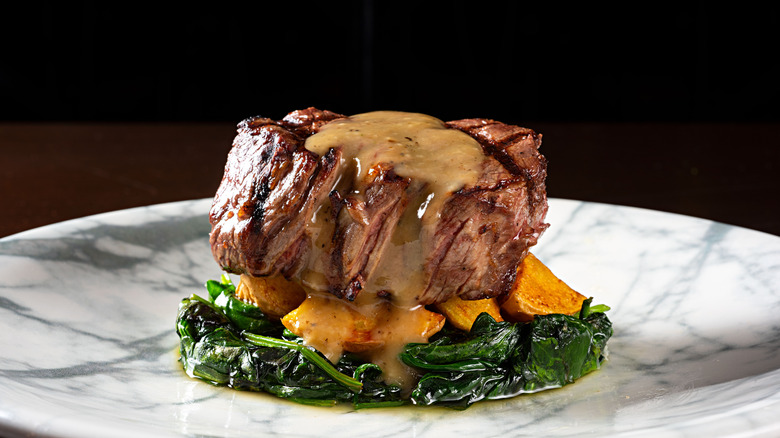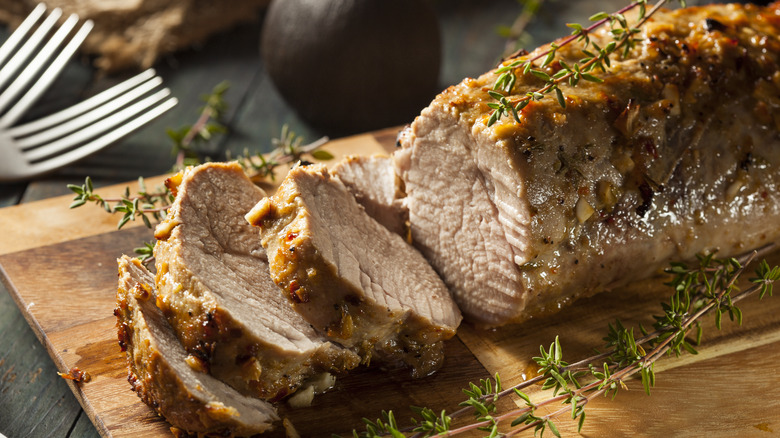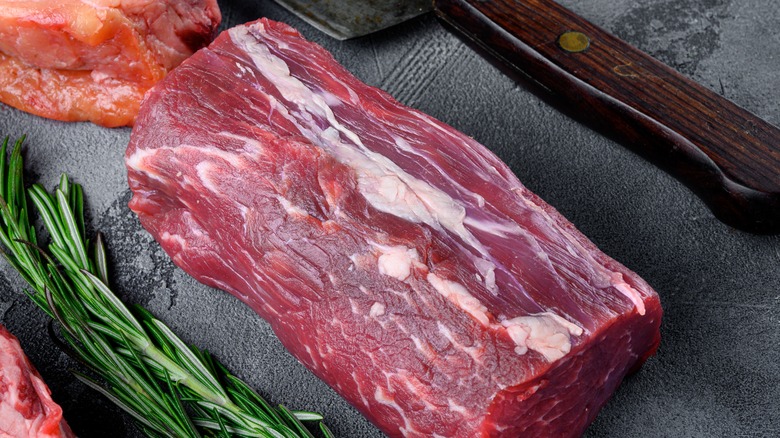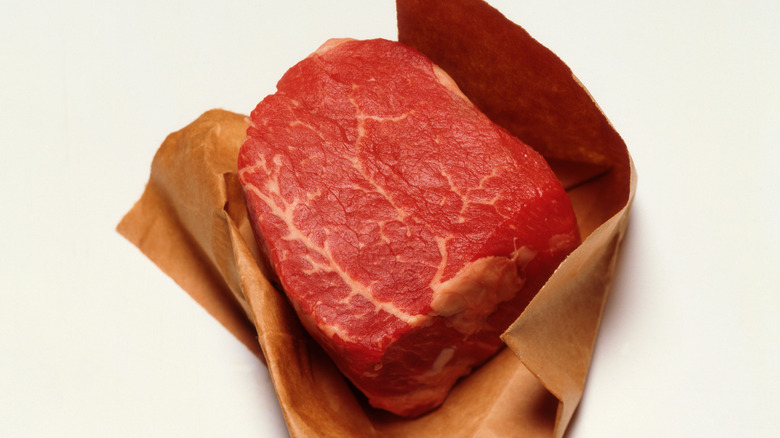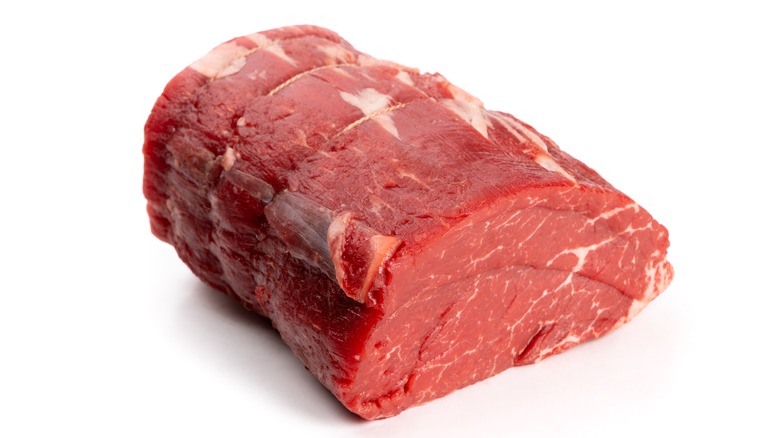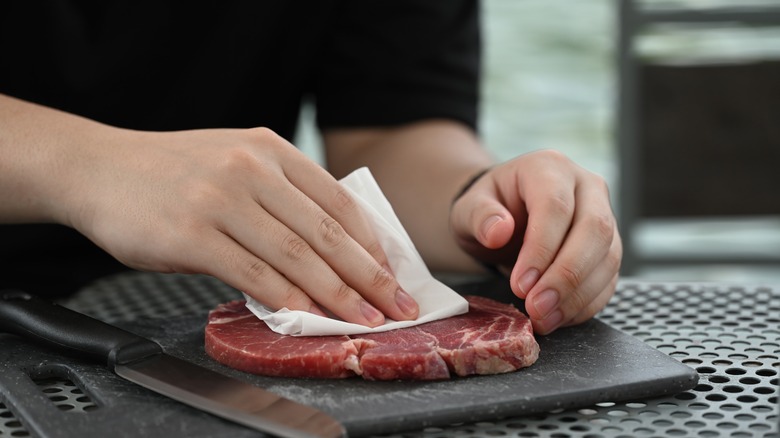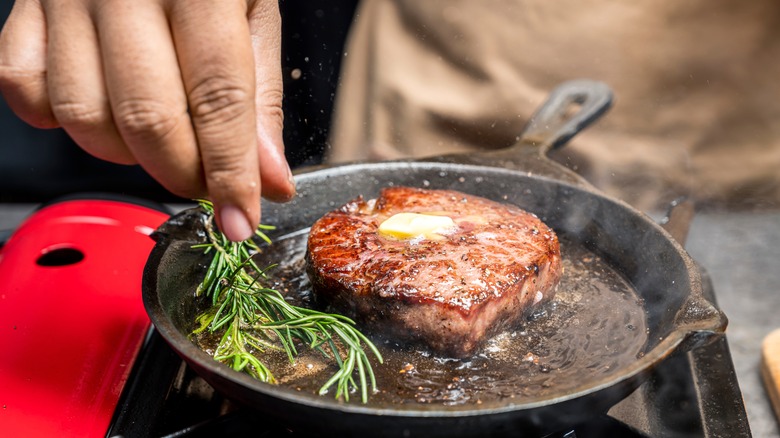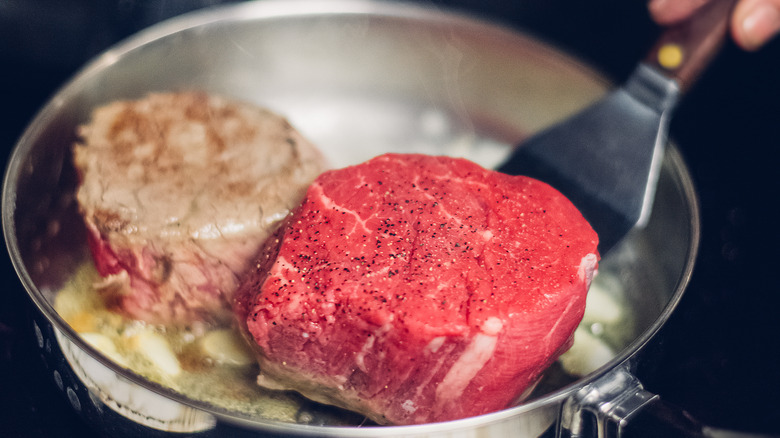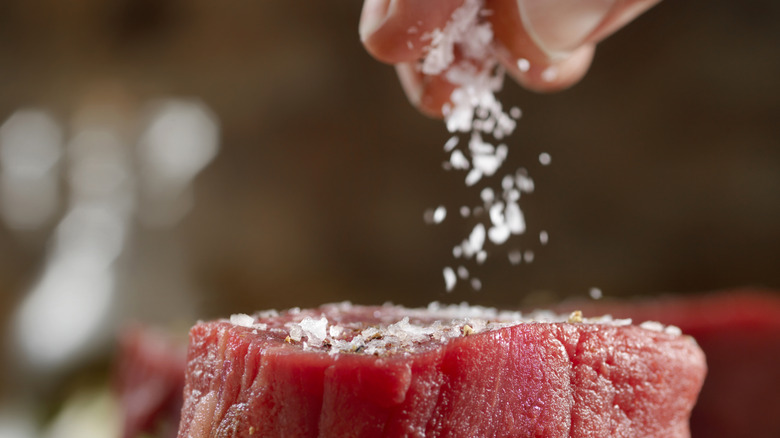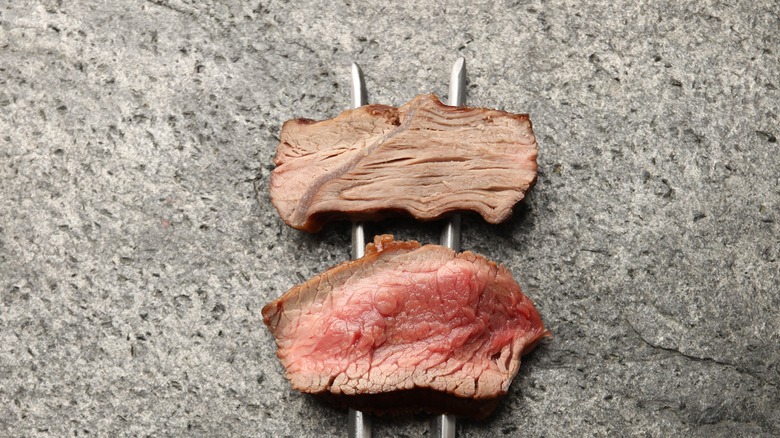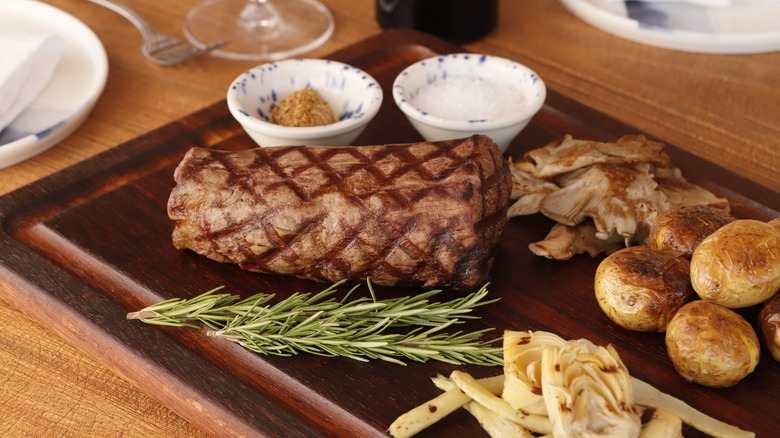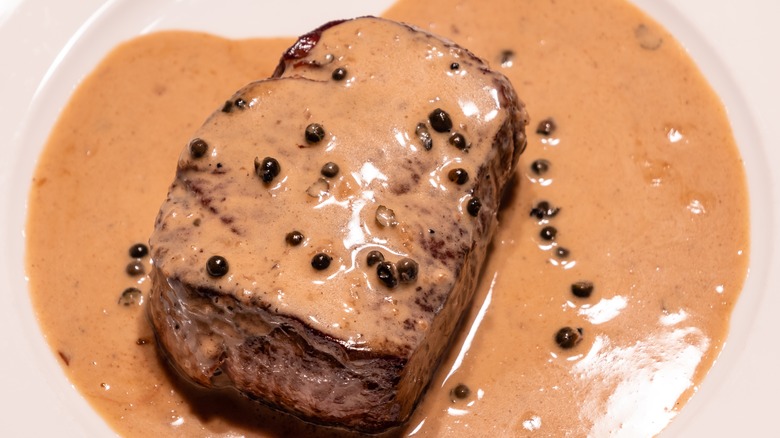11 Big Mistakes Everyone Makes When Cooking Tenderloin
Beef tenderloin may well be one of the most versatile steaks out there. Tender and lean, this choice cut is as happy sliced into thick rounds and cooked like a steak or trussed and roasted to be shared at a dinner party, as delicious fresh out of the pan served with a pile of crispy french fries. It can also be thinly sliced and piled onto a roll for one of the most extra glow-ups a roast beef sandwich ever did see.
Generally, beef tenderloin is perceived as a special occasion treat, and it's not hard to see why. This buttery cut comes from the loin primal, home to some of a steer's tenderest steaks. And the tenderloin specifically, a long, cylindrical steak that runs along the sides of the spine, is perhaps the tenderest on the cow, thanks in large part to the fact that it's a muscle that barely does any work, according to Aki Suzuki, general manager of American Cut. This tenderness makes it one of the most sought-after and expensive cuts of beef ... which makes it all the more important not to mess it up. If you're a home cook seeking mastery of beef tenderloin, look no further: Our experts are here to help identify some of the biggest mistakes everyone makes when cooking tenderloin at home.
1. Not choosing the right steak
When we're talking about tenderloin, most people assume beef. But steers are not the only animals with a tenderloin muscle. Your average butcher shop or meat counter is also likely to be home to pork tenderloin and even chicken tenderloin, aka chicken tenders, both of which boast the same tenderness these cuts are named for.
But even if you zero in on beef from the get-go, there are a few missteps you can make in purchasing. First off, it's important to know the difference between beef tenderloin and filet mignon. The latter is the tenderest part of the tenderloin, located at the end of the long, lean muscle, and is generally the most sought-after part of the cut and may even be more expensive. That said, filet mignon can be confused with other, less tender beef filets if you don't examine the packaging carefully.
Even once you've found the right cut in the butcher case, there are a few things you can check for to ensure you've got the best of the best. "Always buy your steaks from someone you trust," suggests Matthew Kreider, executive chef of Steak 954. "I prefer not to buy mine from big name grocers. Find a butcher or a grocer with a good program that can tell you where your steak is coming from." And Aki Suzuki notes that you can basically guarantee an even more flavorful steak by looking "for a bright red color with fine marbling (intramuscular fat)."
2. Not trimming beef tenderloin properly
Once you've found the perfect steak, it's time to cook — right? Not quite. Depending on how you purchase beef tenderloin, it may require a bit of trimming. While often, beef tenderloin is sold already cleaned or even sliced into medallions ready for cooking, a whole beef tenderloin includes not just the tender loin itself, but also a fair amount of silver skin and excess fat, not to mention the chain muscle. All of this must be trimmed before cooking the tenderloin, with about 30% of the tenderloin purchased being removed before you even start cooking. That may seem like a lot of extra work, not to mention quite a bit of waste for a cut that tends to sell for a whopping $30 a pound.
But don't even think about throwing these valuable pieces away — while they might not cook up quite like beef tenderloin, there's loads of flavor in these trimmings. The chain muscle can be chopped and sautéed to be enjoyed in steak fajitas or a Chinese takeout-inspired beef and broccoli stir-fry, for example, while the other trimmings can be used to make stock, broth, or ground into burger meat, according to Aki Suzuki. "Lean beef trimmings are very useful as a start for sauces," adds Matthew Kreider. Consider using them to make a rich, delicious no-drippings gravy to serve with your roasted beef tenderloin or cooking them down into a luscious au jus.
3. Forgetting to temper beef tenderloin before cooking
Once you've trimmed the tenderloin, there's another essential step required in getting it ready for cooking: tempering. Many chefs agree that beef is happiest when cooked, not from fridge temperature, but rather from room temperature. This, according to Aki Suzuki, helps ensure even doneness throughout.
While the thought process behind tempering beef certainly makes sense — after all, if the center of the beef is no longer fridge cold, it would ostensibly heat up more quickly — not all experts are in agreement regarding this method. J. Kenji López-Alt notably tested this theory for Serious Eats, and after bringing steak to room temperature before cooking it and cooking steak from fridge temperature, he found that it barely made a difference to the ultimate doneness. And if you ask the USDA, from a food safety perspective, you never want to leave any meat out of the fridge for longer than two hours. So when it comes to this tempering tip, feel free to follow our experts' advice if you like, but if you forget, don't worry too much.
4. Not tying your beef tenderloin before roasting it
Depending on how you're cooking your beef tenderloin, you may want to break out the butcher's twine before getting started. "Tying a tenderloin roast helps it cook evenly," explains Aki Suzuki, who notes nevertheless that this method is only really necessary if you're cooking the tenderloin as a whole roast. "For filet mignon, tying is usually unnecessary unless you want to maintain a perfect round shape," he says. That said, if you ask Matthew Kreider, a more uniform shape isn't just about aesthetics. He claims that a nice, round shape can also contribute to "a more uniform cook."
"You can cook these steaks without it," Kreider adds, "however it can be a nice touch." As for how to go about trussing your roast, you'll want to tie loops about every inch, using one, continuous strand of butcher's twine. It can take a bit of time to get the hang of it, so it's best to rely on an expert like Martha Stewart, who has a great video showing you how to manage this at home. That said, if you're at a loss, a good butcher should be able to take care of this step for you. All the more reason to follow Kreider's advice in seeking out a top-notch purveyor when sourcing your beef tenderloin.
5. Cooking damp beef tenderloin
Beef tenderloin is a very tender steak — of that you can be sure. But as is often the case, its tenderness is inversely related to its richness in flavor. To put it bluntly, beef tenderloin can be a bit blander than some of its more marbled cousins. As a result, it's even more necessary to get a lovely brown char on the outside of this steak than it is with other cuts of beef, as the Maillard reaction will help bring out even more of its flavor. The one thing that has the potential to get in your way? Moisture.
"You do not want that layer of moisture between the sear and the steak," explains Vanessa Parish, private chef and executive director of Queer Food Foundation. "It causes that moisture to evaporate once it hits the skillet and can turn your steak gray. I hate to see a steak lose that nice crust opportunity." So be sure to pat your steak dry thoroughly with paper towels before cooking it. Or, do as Matthew Kreider does, and go one step further. "I like to air dry my steaks overnight," he says, "so they get a much nicer crust." This can easily by done by placing the steak on a rack set over a baking dish and setting it in the fridge overnight.
6. Not using enough fat to cook your beef tenderloin
Beef tenderloin is a relatively lean cut, which means that it can be a heart-healthy choice. But from a flavor standpoint, if you're looking to bring out all of its richness, adding a bit of fat never hurt. While Matthew Kreider asserts that "you don't need a lot of fat to cook these steaks," he does note that finishing with a bit of fat adds loads of flavor. "I love to baste mine in some brown butter with [a] garlic clove and thyme," he says. And gilding the lily with a round of compound butter is a great way to push its tastiness up to 11.
Kylian Goussot, executive chef at Lafayette Steakhouse in Miami, Florida, agrees. "Since these cuts are very lean, it is advisable to add some fat, such as butter or oil, to prevent them from drying out during cooking and to enhance their flavor," he says. "Personally, I love using butter to enhance the rich flavor of the steak." But while butter may well be the perfect finishing fat, it's actually not the best idea when it comes to cooking the steak itself. For that, you'll want to use a fat that can stand fairly high temperatures, such as canola oil or avocado oil. These fats, explain Aki Suzuki, have a high enough smoke point to allow you to get the perfect sear on your steak without adding any unpleasant burnt flavors.
7. Cooking beef tenderloin at too low a temperature
The last essential element when it comes to getting the perfect brown crust on the outside of your steak is the temperature you're cooking at. Cooking beef at a fairly high temperature is the best way to get a lovely browned exterior, explains Matthew Kreider. This goes double when it comes to leaner steaks like tenderloin, which Kreider says are even easier to overcook than fattier steaks like ribeye. "I always cook leaner steaks like this quickly so as not to overcook them and to get a nice sear," he says.
Aki Suzuki agrees, noting he prefers a double-barreled approach when cooking beef tenderloin. "Start with a high temperature to sear and create a crust," he suggests, "then finish at a lower temperature (in the oven) to ensure even cooking." Using a cast-iron skillet, which is known for its ability to retain high temperatures, is perhaps the best approach here. Not only will it work wonders for getting the perfect sear on the stovetop, but it can be transferred directly into the oven, for minimal cleanup.
8. Underseasoning beef tenderloin
Given the mild flavor of beef tenderloin, it's essential to season it well. "Don't forget to season generously with salt and pepper before searing," suggests Aki Suzuki. But within this recommendation, there are two potential stumbling blocks. The first is the lack of specificity that comes with the word "generously." As a rule of thumb for seasoning steak perfectly, a tablespoon of salt for every pound of meat is a good bet.
The second stumbling block has to do with when "before" is. Some prefer to season their meat hours or even two days in advance. This approach ensures that the salt will penetrate past the crust and into the meat itself. But if you haven't had time to season quite that far in advance, be forewarned: There's a window where seasoning early can actually be your downfall. By and large, if you season up to 40 minutes before cooking, you're probably in the clear. Any later than that, however, and seasoning early will only bring moisture to the surface of the meat, making it difficult for the perfect brown crust to form. If you haven't had a chance to season your beef tenderloin well in advance, it's best to season just before cooking for best results.
9. Overcooking beef tenderloin
No one likes overcooked steak, but it's particularly unappealing when it comes to beef tenderloin, whose lack of fat can make it doubly dry if too well-done. And to add insult to injury, unfortunately, its lack of fat makes beef tenderloin even more susceptible to accidental overcooking than many other cuts of steak, according to Matthew Kreider. "It can be extremely easy to overcook these steaks," he says. "There is not a lot of fat in them, so they will cook faster and rest further than lets say a striploin or a ribeye."
Aki Suzuki agrees, noting that "due to their low fat content," both tenderloin and filet mignon "can quickly become overcooked and dry." He recommends leaving nothing to chance: Use a meat thermometer to gauge when beef tenderloin has reached the ideal medium-rare temperature: 130–135 degrees Fahrenheit. Vanessa Parish, meanwhile, offers another suggestion: cooking tenderloin as a roast, which she says can be more forgiving than cooking them from start to finish in a pan. "Searing on the outside and then placing in the oven lets this lean meat come to a perfect medium-rare temperature without a high fear of overcooking," she says.
10. Forgetting to rest beef tenderloin after cooking it
Once you've cooked beef tenderloin to perfection, it can be tempting to dig right in. Resist that urge. It's essential that beef rest before carving, according to Aki Suzuki, to ensure that the juices can redistribute within the meat. "Always rest your steaks. Please always rest your steaks," echoes Matthew Kreider. "Your steak deserves it, you deserve it. It will be so much more tender and juicier if you let it rest."
As for how long to rest your meat, Suzuki recommends at least five to 10 minutes, though the actual time really depends on the size of the steak. Thinner cuts can rest for a mere five to seven minutes, while thicker steaks and roasts may need to rest 10 minutes or up to 20. As a rule of thumb, Kreider recommends a resting time of between a third and half of the original cook time to usher the steak to perfection. Tenting steak loosely with foil will keep it from going cold as you wait without allowing too much moisture to build up, softening that crispy crust you worked so hard to develop.
11. Forgetting about a great sauce
While the steak rests, you've got just enough time to whip up a delicious sauce. And while purists may scoff, don't overlook the way a top-notch sauce can push the flavors of mild-mannered beef tenderloin to utter perfection. Matthew Kreider even terms the steak a "sauce sponge," noting that a wide variety of sauces can suit the cut perfectly. Some of the best sauces to serve with beef tenderloin are pan sauces, which take full advantage of all of the flavorful fond left in the bottom of the pan after cooking. Bring up this fond using cognac for the beginnings of a classic au poivre sauce, or use red wine and cook it down by half before emulsifying it with butter to make a tasty red wine reduction.
But pan sauces are not your only option. Horseradish-infused crème fraîche is a classic sauce to serve with roast beef that goes just as wonderfully with beef tenderloin, while a classic béarnaise sauce adds all the richness this steak needs to take it to next-level deliciousness. If you want something a bit lighter, an Argentinian-inspired chimichurri redolent with fresh herbs and acid can be the perfect pair. No matter which sauce you choose, be sure you've got a lovely starch like mashed potatoes, french fries, or some crusty bread to help mop up any extra!
